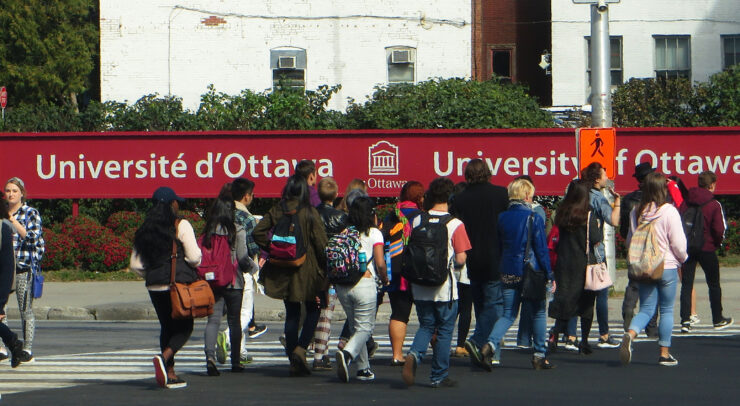U of O is budgeting for a cash deficit of $81.0 million
The University of Ottawa’s proposed 2020-2021 budget was released by the Board of Governors on May 27. The budget presents the originally planned budget for the 2020-21 year as well as a new proposed budget which takes into account the COVID-19 pandemic’s impact on the 2020-21 academic year.
The University of Ottawa is predicting significantly large deficits that will impact students and staff alike.
Pre COVID-19 the U of O was already faced with an income reduction due to the Progressive Conservative government’s tuition freeze enacted in Jan. 2019. The ban was also accompanied by a 10 per cent cut to post-secondary tuition fees across Ontario.
The 10 per cent tuition cut went into full effect for domestic students in Sept. 2019, with those fees frozen as well for the 2020-2021 academic year. International student fees, however, were not subject to the cut.
The University of Ottawa states that this tuition cut has cost the institution more than $45 million in lost revenue, revenue that it failed to account in its Dec.2018 forecasts of the provincial bill’s impact on the institution’s bottom line.
Tuition fees account for around 50 per cent of the University of Ottawa’s operating funds.
Post COVID-19, the U of O has prepared four scenarios to address lower enrolment due to the pandemic. Because of COVID-19, many students will not return to the U of O in the fall, and may not choose to enroll at all for the 2020-21 academic year. Of the four scenarios, the U of O modeled their post-COVID-19 plan after scenario number two, which reflects a $54.1 million loss in tuition fees, an 11.3 per cent decline from the 2019-2020 academic year.
This scenario shows the budget issues would largely be due to fewer freshmen enrolling and fewer upper-year students returning. The scenario represents the middle ground between the four scenarios, with one yielding more promising enrolment numbers and with the other two predicting more serious repercussions with progressively lower enrolment from scenario to scenario. In the chosen post-COVID-19 model, the U of O proposes that there will be 10 per cent fewer new domestic students than in the fall of 2019, and 50 per cent fewer new international students.
As for returning students, a five per cent decrease in domestic students is expected and a 15 per cent decrease in international students is expected. Scenarios number three and number four reflect a $32.1 million deficit and a $86.1 million deficit respectively. The institution has also stated that should scenario number three occur, it would represent a ‘material impact on tuition fee income’. The fourth scenario shows a $119.6 million deficit. Scenario number four was not addressed directly in the budget plan, as it is deemed highly improbable.
Dr. David Gray, a professor of economics at the University of Ottawa says he was more ‘hopeful’ for the U of O’s budget.
“The University has a 150 year history of fairly conservative budgeting and saving,” said Gray.
The University states in it’s budget that it has a large savings account of $10 million cash balance in the bank account as well as an additional $259 million in short-term investments.
Dr. Gray said that compared to other universities, the U of O has a fairly decent savings account to help them through COVID-19 related financial challenges.
The Faculty of Social Sciences professor also spoke of other changes facing the University of Ottawa’s staff and students.
According to Gray, due to budgeting and a decreased operating fund, the University is unlikely to hire new professors which may ultimately lead to larger class sizes and fewer course offerings.
“The University has also hired significantly more technicians and mental health services professionals to handle the online version of courses and help support students during the pandemic,” Gray said.
Overall, the University of Ottawa is proposing a $65.8 million loss for the 2020-2021 academic year in total revenue and expenditures. With regard to liquidity and the cash flow in the bank, due to COVID-19 the University is expecting a cash deficit of $81.0 million. The University states that “from a cash perspective, there is adequate cash to operate the University for next year”.
In spite of the projected losses, the University of Ottawa plans on increasing salaries for its staff.
“From an expenditure perspective, there is also no significant change with respect to scholarships and student aid budgets,” the U of O stated in their 2020-21 budget. “Salaries and benefits have been budgeted to increase between one per cent and two per cent for 2020-2021, either due to contractual obligations or general increases, depending on union category. These increases are reflected in the budget, the total estimated cost of which is $11.3 million.”
There was also no significant change in certain lines of the Operating Expenses and the Ancillary Entreprises Expenses, specifically regarding the Maintenance, Repairs and Public Services lines, and the cost of Goods and Services.
“These costs make up significant portions of the budget, and with no students currently on campus and presumably not many students on campus at least for the beginning of the Fall semester, it could be interesting to further examine these costs, as they may not be as high as budgeted in the end,” said S.G Arsenault a fourth-year student in Economics and Public Policy in an email to the Fulcrum.
As the COVID-19 pandemic continues, the Board of Governors, in conjunction with the U of O administration will remain flexible regarding the budget.
Throughout the 2020-2021 academic year, the BOG will continue to update and monitor the projections for the budget as enrollment numbers for the institution’s fall semester become known.





